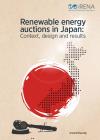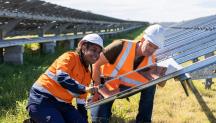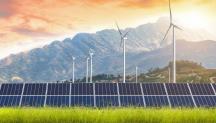

-
-
IRENA (2021), Renewable energy auctions in Japan: Context, design and results, International Renewable Energy Agency, Abu Dhabi
Copied
/-/media/Files/IRENA/Agency/Publication/2021/Jan/IRENA_Auctions_Japan_2021.pdf?rev=7ef03c11a72b44449003e58be077bb0c
Copied
Renewable energy auctions in Japan: Context, design and results
Newsletter
Japan has long been a major energy importer, relying heavily on fossil fuels to meet household and community electricity needs as well as transport and industrial energy demand. Although the country initially opted for nuclear plants to diversify its energy mix, the disaster at Fukushima in 2011 prompted a fundamental shift in Japanese energy policy.
With nuclear power increasingly excluded from the future energy mix, renewable energy technologies have become a central element in Japanese power and energy planning. Auctions, meanwhile, have emerged as the key policy instrument driving the national transition to renewables.
This report by the International Renewable Energy Agency (IRENA) outlines the country's experience with auctions for solar, wind and biomass power generation. Japan's renewable energy auctions are price-centred and tend to prioritise simple design elements.
Among the findings:
- By late 2020, Japan had conducted five solar photovoltaic (PV) and two biomass auctions. It also initiated a zone-specific offshore wind auction in June 2020. A feed in premium (FiP) scheme announced in 2020 to promote renewable energy use was set to be introduced in 2022.
- To date, bidders have been awarded almost one-third of the originally announced volumes from the five solar PV auctions, with 574 megawatts (MW) awarded out of the total 1 663 MW auctioned. No biomass project has yet been contracted through renewable energy auctions.
- Average awarded prices in the solar PV auctions fell by more than 35% between the first and fifth rounds. Yet solar PV prices in Japan are still higher than the global average.
- Solar PV prices in Japan are also high compared to those achieved in other countries with similar macro-economic conditions and levels of solar energy development.
- Relatively high price results do not necessarily tarnish an auction's success. The average awarded prices were close to the existing costs of electricity for solar PV power in Japan, underscoring the price discovery aspect of the auction process.
- The main factor behind Japan's high solar power prices is its relatively high installation and building costs, as well as the cost of modules and inverters. Risk perceptions as the market explores new energy sources can also increase prices.




